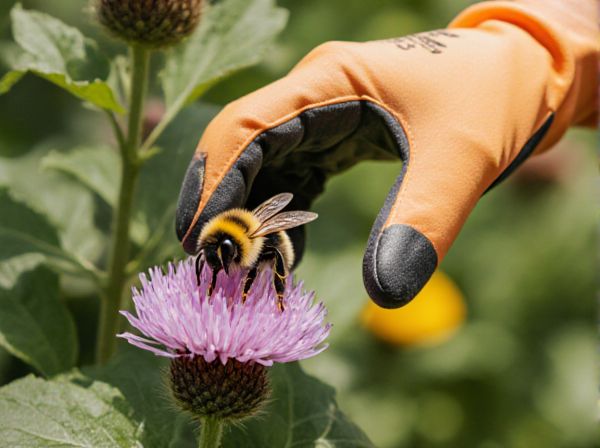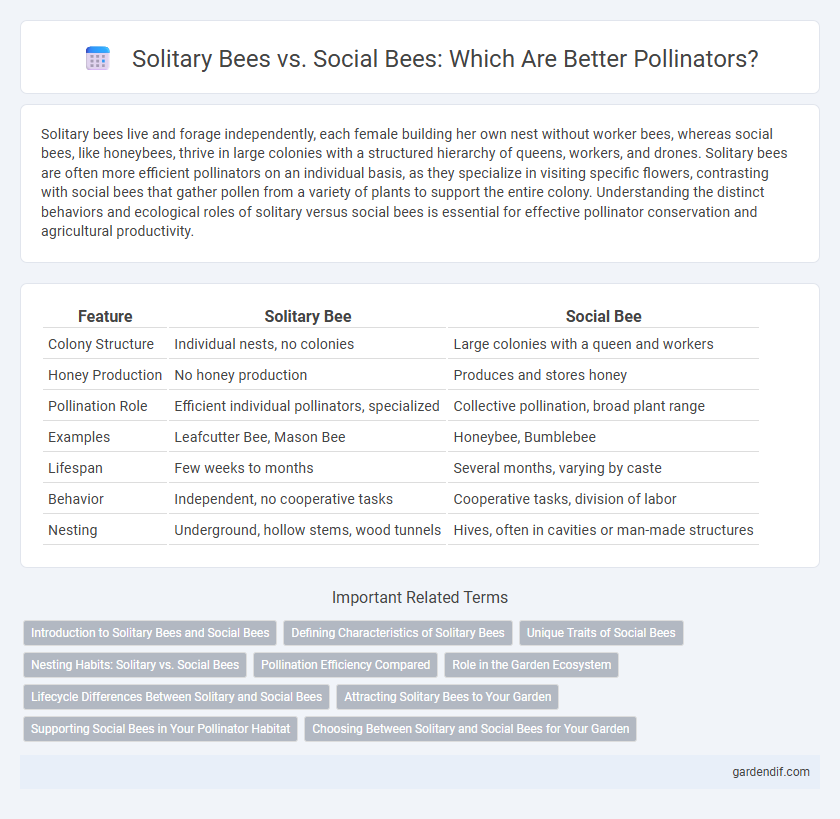
Solitary Bee vs Social Bee Illustration
Solitary bees live and forage independently, each female building her own nest without worker bees, whereas social bees, like honeybees, thrive in large colonies with a structured hierarchy of queens, workers, and drones. Solitary bees are often more efficient pollinators on an individual basis, as they specialize in visiting specific flowers, contrasting with social bees that gather pollen from a variety of plants to support the entire colony. Understanding the distinct behaviors and ecological roles of solitary versus social bees is essential for effective pollinator conservation and agricultural productivity.
Table of Comparison
| Feature | Solitary Bee | Social Bee |
|---|---|---|
| Colony Structure | Individual nests, no colonies | Large colonies with a queen and workers |
| Honey Production | No honey production | Produces and stores honey |
| Pollination Role | Efficient individual pollinators, specialized | Collective pollination, broad plant range |
| Examples | Leafcutter Bee, Mason Bee | Honeybee, Bumblebee |
| Lifespan | Few weeks to months | Several months, varying by caste |
| Behavior | Independent, no cooperative tasks | Cooperative tasks, division of labor |
| Nesting | Underground, hollow stems, wood tunnels | Hives, often in cavities or man-made structures |
Introduction to Solitary Bees and Social Bees
Solitary bees, unlike social bees, do not live in colonies and each female independently builds and provisions her own nest, making them efficient pollinators of diverse plants. Social bees, such as honeybees and bumblebees, live in complex colonies with a division of labor that enhances their ability to pollinate large areas. Understanding the distinct behaviors and nesting habits of solitary versus social bees is crucial for optimizing pollination strategies in agriculture and conservation.
Defining Characteristics of Solitary Bees
Solitary bees are defined by their independent nesting behavior, where each female constructs and provisions her own nest without cooperative brood care. Unlike social bees, they lack a queen-worker caste system, and their nests are often located in soil, wood, or plant stems. These bees play a crucial role in pollination, exhibiting diverse foraging habits tailored to specific plants.
Unique Traits of Social Bees
Social bees exhibit complex colony structures with distinct roles such as workers, drones, and queens, which enhance their efficiency in pollination. They communicate through sophisticated behaviors like the waggle dance to direct nestmates to abundant floral resources. Their cooperative foraging and nesting strategies result in higher pollination rates compared to solitary bees.
Nesting Habits: Solitary vs. Social Bees
Solitary bees nest individually, often in tunnels in soil, wood, or hollow stems, creating separate brood cells for each offspring, which reduces disease transmission risk. Social bees, such as honeybees and bumblebees, build communal nests with complex structures that support cooperative brood care and division of labor. Nesting habits influence pollination efficiency and ecosystem roles, with solitary bees excelling in diverse habitats and social bees dominating large-scale pollination.
Pollination Efficiency Compared
Solitary bees typically exhibit higher pollination efficiency per individual due to their focused foraging behavior and specialized floral preferences, resulting in effective pollen transfer. Social bees, such as honeybees, contribute to pollination through large colony sizes but show lower individual efficiency due to generalized foraging patterns and resource sharing within the hive. Studies indicate solitary bees often outperform social bees in pollination of specific crops like orchard fruits and legumes, enhancing crop yield and quality.
Role in the Garden Ecosystem
Solitary bees contribute significantly to garden ecosystems by providing efficient pollination for a wide variety of plants, often specializing in particular flower species, which enhances biodiversity. Social bees, such as honeybees and bumblebees, support large-scale pollination through their colony-based foraging, ensuring robust fruit and vegetable yields. Both solitary and social bees play complementary roles in maintaining healthy plant populations and promoting ecological balance in garden environments.
Lifecycle Differences Between Solitary and Social Bees
Solitary bees complete their entire lifecycle independently, with females individually constructing nests, laying eggs, and provisioning each brood cell without worker assistance. Social bees, such as honeybees, exhibit a complex lifecycle that includes a reproductive queen, many sterile female workers, and males, all cooperating within a communal nest to rear offspring. Lifecycle stages in social bees are marked by division of labor and overlapping generations, whereas solitary bees undergo a singular developmental cycle per individual.
Attracting Solitary Bees to Your Garden
Solitary bees, unlike social bees such as honeybees and bumblebees, do not live in colonies, making them less aggressive and highly efficient pollinators for home gardens. To attract solitary bees, provide nesting habitats like bee hotels, bare soil patches, and dead wood, along with diverse native flowering plants that bloom throughout the growing season. These targeted efforts increase pollination rates for fruits, vegetables, and wildflowers, supporting biodiversity and enhancing garden productivity.
Supporting Social Bees in Your Pollinator Habitat
Supporting social bees in your pollinator habitat enhances biodiversity and boosts pollination efficiency, as these bees, such as honeybees and bumblebees, thrive in colonies and have complex social structures. Providing ample floral resources, nesting materials, and a pesticide-free environment encourages colony growth and resilience. Incorporating diverse native plants and maintaining habitat connectivity further supports social bee populations, promoting a robust ecosystem.
Choosing Between Solitary and Social Bees for Your Garden
Choosing between solitary and social bees for your garden depends on pollination needs and garden size. Solitary bees, such as mason bees, are efficient pollinators that require minimal space and are ideal for small gardens due to their independent nesting habits. Social bees, like honeybees and bumblebees, thrive in colonies, provide extensive pollination, and support large-scale garden ecosystems with their perennial hive structures.
Solitary Bee vs Social Bee Infographic

 gardendif.com
gardendif.com